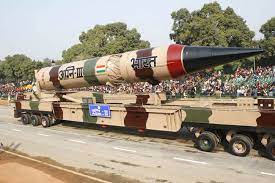Agni-3
2022 NOV 25
Preliminary >
Science and Technology > Defence technology > Missile defence systems

Why in news?
- India has carried out a successful training launch of an Intermediate Range Ballistic Missile, Agni-3 from APJ Abdul Kalam Island, Odisha..
About Agni-3:
- Agni-3 is an Intermediate Range Ballistic Missile developed by Defence Research and Development Organisation (DRDO).
- The first known developmental trial of Agni-3 was conducted back in 2006, but could not yield the expected result. It was later subsequently successfully flight-tested in 2007 and the system has been successfully tested several times since then.
- The missile is powered by a two-stage solid propellant system.
- The missile has a strike range of over 3,000 and is capable of carrying both conventional and nuclear warheads.
- It can carry a warhead of 1.5 tonnes, which is protected by a carbon all-composite heat shield.
History of Agni missiles:
- India began testing the Agni series of missiles in 1989 with the first test for Agni 1, an Intermediate Range Ballistic Missile, with a range of around 1,000 km
- It was developed under the Integrated Guided Missile Development Program (IGMDP)
- At that time only the US, the erstwhile Soviet Union, China, France and Israel, had IRBM technology.
- Since then, DRDO labs have continued to work on it, bringing the latest available Agni 5 to its present capability.
- In addition to the IRBM-capable nations, only North Korea and the UK have ICBM technology at the moment.
- The next generation of the missile, Agni VI, under development, is expected to have a range of around 8,000 km.
Range of Agni Class of Missiles:
- Agni I: Range of 700-800 km.
- Agni II: Range more than 2000 km.
- Agni III: Range of more than 2,500 Km
- Agni IV: Range is more than 3,500 km and can fire from a road mobile launcher.
- Agni-V: The longest of the Agni series, an Inter-Continental Ballistic Missile (ICBM) with a range of over 5,000 km.
IGMDP (Integrated Guided Missile Development Program):
- It was conceived by Dr. A.P.J. Abdul Kalam to enable India attain self-sufficiency in the field of missile technology.
- It was approved in 1983 and completed in 2012.
- The 5 missiles (P-A-T-N-A) developed under this program are:
- Prithvi: Short-range surface-to-surface ballistic missile.
- Agni: Ballistic missiles with different ranges, i.e., Agni (1,2,3,4,5)
- Trishul: Short-range low-level surface to air missile.
- Nag: 3rd generation anti-tank missile.
- Akash: Medium-range surface-to-air missile.
PRACTICE QUESTION:
Consider the following statements regarding ‘Agni’ class of missiles:
1. They are supersonic cruise missiles
2. They are capable of carrying both conventional and nuclear warheads
Which of the statements given above is/are correct?
(a) 1 only
(b) 2 only
(c) Both 1 and 2
(d) Neither 1 nor 2
Answer
